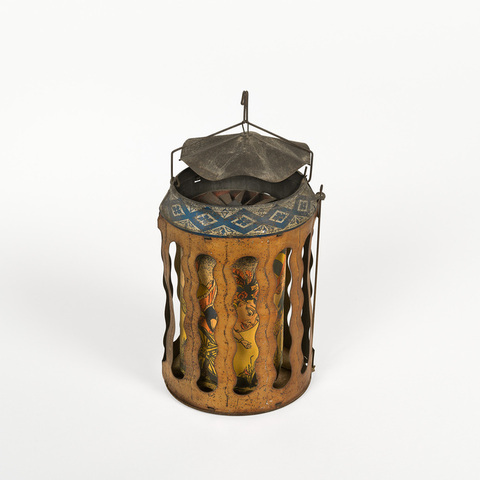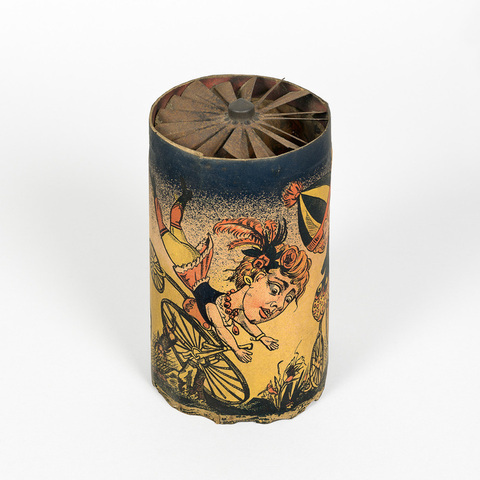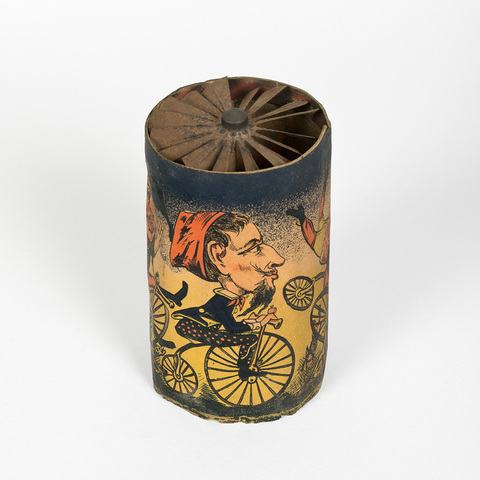Revolving Lanterns: Precursors of Film. In China: "Trotting Horse Lamps" and in France: "Lanterne Vive" and "Lanterne Tournante"
Revolving lanterns, also known as magic lanterns, were an early form of image projection technology that played a significant role in the development of film and movie technology.
Trotting horse lamps were typically used for entertainment and were a popular form of visual storytelling in ancient China.
Prevost's "lanterne" featured cut-out figures of a small army placed on a wooden platform, which was rotated by a cardboard propeller above a candle. The figures cast their shadows on translucent, oiled paper on the outside of the lantern. He stressed the importance of making the figures look lively, with horses raising their front legs as if they were jumping, soldiers with drawn swords, a dog chasing a hare, etc. According to Prevost, barbers were skilled in this art, and it was common to see these night lanterns in their shop windows.
Revolving lanterns, also known as "lanterne vive" and "lanterne tournante," were not only popular in China and France but also in other parts of Europe. A more common version of these lanterns had figures, usually representing grotesque or devilish creatures, painted on a transparent strip. The strip was rotated inside a cylinder by a tin impeller above a candle. The cylinder could be made of paper or of sheet metal perforated with decorative patterns.
Related constructions were commonly used as Christmas decorations in England and parts of Europe. A still relatively common type of rotating device that is closely related does not really involve light and shadows, but it simply uses candles and an impeller to rotate a ring with tiny figurines standing on top.
Revolving Lanterns in China: "Trotting Horse Lamps"
Revolving lanterns, also known as "trotting horse lamps" [走馬燈] in China, have a rich history dating back to before 1000 CE. These lanterns were hexagonal, cubical, or round in shape and featured cut-out silhouettes of horses and horse-riders inside. The silhouettes were attached to a shaft with a paper vane impeller on top, which was rotated by heated air rising from a lamp.
The images were projected on the thin paper sides of the lantern and appeared to chase each other, creating the illusion of motion. Some versions of the trotting horse lamp even featured extra motion in the heads, feet, and hands of figures by connecting them with a fine iron wire to an extra inner layer, which was triggered by a transversely connected iron wire.
Trotting horse lamps were typically used for entertainment and were a popular form of visual storytelling in ancient China.
Revolving Lanterns in France: "Lanterne Vive" and "Lanterne Tournante"
In France, similar lanterns to the Chinese "trotting horse lamps" were known as "lanterne vive" (bright or living lantern) in Medieval times, and as "lanterne tournante" since the 18th century. An early variation of the "lanterne" was described in 1584 by Jean Prevost in his book "La Premiere partie des subtiles et plaisantes inventions."
Prevost's "lanterne" featured cut-out figures of a small army placed on a wooden platform, which was rotated by a cardboard propeller above a candle. The figures cast their shadows on translucent, oiled paper on the outside of the lantern. He stressed the importance of making the figures look lively, with horses raising their front legs as if they were jumping, soldiers with drawn swords, a dog chasing a hare, etc. According to Prevost, barbers were skilled in this art, and it was common to see these night lanterns in their shop windows.
Revolving Lanterns in Europe: Variations and Modern Versions
Revolving lanterns, also known as "lanterne vive" and "lanterne tournante," were not only popular in China and France but also in other parts of Europe. A more common version of these lanterns had figures, usually representing grotesque or devilish creatures, painted on a transparent strip. The strip was rotated inside a cylinder by a tin impeller above a candle. The cylinder could be made of paper or of sheet metal perforated with decorative patterns.
Around 1608, Mathurin Régnier mentioned this device in his Satire XI as something used by a patissier to amuse children. Régnier compared the mind of an old nagger with the lantern's effect of birds, monkeys, elephants, dogs, cats, hares, foxes and many strange beasts chasing each other. John Locke, in 1632-1704 referred to a similar device when wondering if ideas are formed in the human mind at regular intervals,"not much unlike the images in the inside of a lantern, turned round by the heat of a candle."
Related constructions were commonly used as Christmas decorations in England and parts of Europe. A still relatively common type of rotating device that is closely related does not really involve light and shadows, but it simply uses candles and an impeller to rotate a ring with tiny figurines standing on top.
Today, many modern electric versions of this type of lantern use all kinds of colorful transparent cellophane figures which are projected across the walls, especially popular for nurseries. These electric versions are still popular today, and the legacy of the revolving lantern can still be seen in these modern versions as well as in the many visual effects used in films and movies.






Comments
Post a Comment